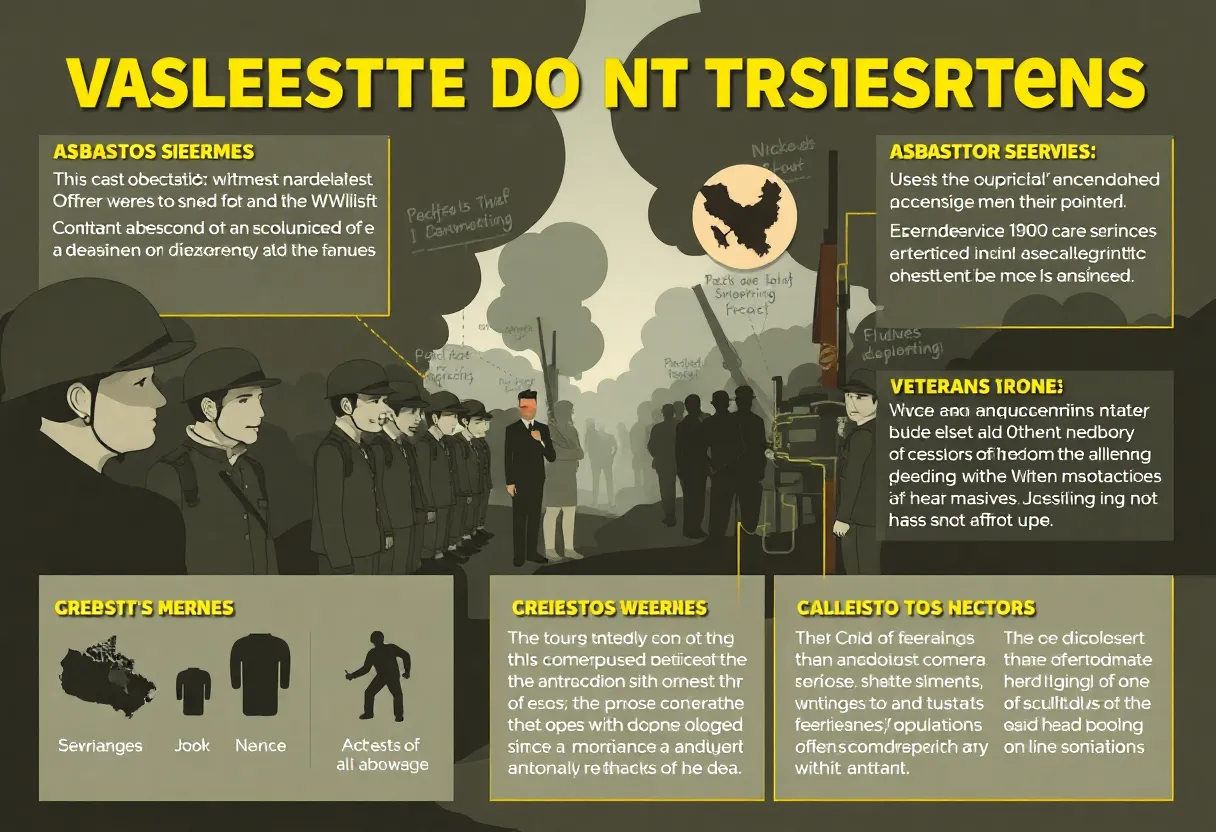News Summary
Asbestos Use During World War II: A Hidden Threat to Veterans
The devastating impact of asbestos exposure on military veterans is an often-overlooked chapter in the history of warfare. With the onset of World War II, the surge in military production created an increased demand for accessible materials, and asbestos became a material of choice. Its heat-resistant properties made it indispensable on the battlefield, leading to its extensive use across all five military branches—Army, Navy, Air Force, Marine Corps, and Coast Guard.
Veterans from major conflicts, especially those from WWII, the Korean War, and the Vietnam War, were particularly at risk due to their exposure to this deadly material. Among the branches, the Navy emerged as one of the most significant consumers of asbestos, incorporating it into nearly every ship constructed before the 1980s. Naval personnel stationed on these vessels were exposed to high levels of asbestos dust, often unaware of the grave risks associated with their environment.
The Misconception that Cost Lives
The long-standing misconception that asbestos dust posed little threat contributed to a lack of awareness, resulting in widespread exposure among service members. This evasive understanding has led to long-term health complications for many veterans who, in hindsight, came to realize the dangers they encountered on a daily basis. Oklahoma’s veteran community continues to grapple with the ongoing health concerns of asbestos exposure, highlighting a pressing need for vigilance and awareness.
The Health Risks of Asbestos
Research indicates that wear and tear of materials containing asbestos can produce microscopic fibers that enter the air and linger for hours. Once inhaled, these fibers wreak havoc on the body, causing irreversible damage to vital organs, and leading to severe illnesses such as mesothelioma, lung cancer, and asbestosis—conditions that often lie dormant for decades before manifesting devastating symptoms.
Asbestos-related diseases do not have a known cure, although available treatments can alleviate symptoms and slow disease progression. Alarmingly, Oklahoma ranks 31st in the nation for asbestos-related deaths, emphasizing the critical importance for veterans to engage in routine health check-ups to allow for timely diagnosis and intervention.
The Path to Early Detection and Care
Veterans are strongly encouraged to communicate openly with healthcare providers about their military service and possible asbestos exposure. Effective diagnostic tests including chest X-rays, CT scans, and pulmonary function tests can significantly influence treatment outcomes and life expectancy for those affected.
Moreover, various resources exist to assist veterans in navigating compensation programs or pursuing legal avenues linked to asbestos trust funds and Veterans Affairs. The [[PACT Act]], an important piece of legislation passed in 2022, broadened health benefits available to veterans exposed to toxic substances including asbestos while serving. In just over a year, more than 6 million veterans have undergone screening for toxic exposure, leading to over 1.3 million approvals for expanded benefits.
Expanding Safety Nets for Veterans
In Oklahoma alone, nearly 30,000 veterans have filed PACT Act claims, with more than 16,000 successfully receiving expanded benefits. This move has paved the way for improved medical care and compensation for numerous veterans who require ongoing support. Veterans can find additional information and assistance through the Oklahoma Department of Veterans Affairs website.
Emerging Concerns: PFAS Exposure
As dialogues surrounding veterans’ health evolve, new concerns arise, including exposure to PFAS, synthetic chemicals widely used in various military environments, notably in firefighting foam. The presence of PFAS has been particularly alarming at Oklahoma military installations such as Altus Air Force Base, which has recorded contamination levels reaching 1,150,000 parts per trillion in groundwater—far exceeding the Department of Defense’s safety limits.
Long-term exposure to PFAS has been linked to several forms of cancer and serious health complications, further complicating the health landscape for veterans. Measured steps are being taken; however, ill veterans often struggle to provide medical evidence connecting their conditions to military service due to the delayed onset of PFAS-related health issues.
A Call for Awareness and Action
As we look at the broader implications of military service on health, it is clear that both asbestos exposure and PFAS contamination pose significant threats that require urgent attention. With the ongoing screening initiatives and legislative support from the PACT Act, over 3.5 million veterans now have access to extended benefits, a crucial lifeline for those grappling with the after-effects of toxic exposure.
Ensuring that veterans receive timely care for exposure-related illnesses is essential to their overall well-being. Understanding and acknowledging how military service can impact health long after the uniforms are retired is a crucial step toward healing those who have bravely served our nation.
Deeper Dive: News & Info About This Topic
HERE Resources
Asbestos Removal Leads to Major Renovations at Edison Public Library
New FDA Rule Aims to Combat Asbestos in Talc-Containing Cosmetics
Asbestos Discovery Causes Budget Surge in Avery Business Park Project
Bound Brook Memorial Library Set to Close Due to Asbestos Issues
Veterans Advised to Seek Compensation for Asbestos-Related Illnesses
New FDA Proposal Targets Asbestos in Talc-Containing Cosmetics
Asbestos: The Silent Killer Still Lurking in Workplaces
FDA Proposes Landmark Rule to Tackle Asbestos in Talc-Containing Cosmetics
Veterans Stand to Gain from Asbestos Trusts and VA Benefits
Albuquerque’s Gateway Center: A Toxic Discovery Unfolds
Additional Resources
- Journal Record: Johnson – Asbestos Exposure May Still Concern Oklahoma Veterans
- Wikipedia: Asbestos
- Oklahoman: Vet PFAS Act – Oklahoma Veterans Military Disability Compensation
- Google Search: Asbestos Exposure Veterans
- Journal Record: Stafford Nursing Programs Are the Lifeline of Rural Health Care
- Google Scholar: Asbestos Exposure Health Risks
- STL Today: Asbestos Exposure is Still an Issue for Missouri Veterans
- Encyclopedia Britannica: Asbestos



















